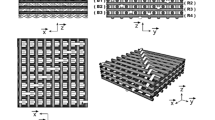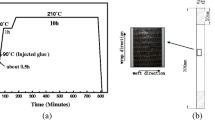Abstract
The failure of woven composites has been examined. This study is presented in two parts:
-
Modelling of failure of woven composites. Part 1: nomenclature defining the interzone concept;
-
Modelling of failure of woven composites. Part 2: experimental and numerical justification of the interzone concept.
In the first part, the concepts of the interzone and the geometry of an interzone have been defined in a general way for a large panel of woven composites. In the second part, it has been shown that the failure of woven composites is well described by using the interzone concept. The load transfer between intact interzones and broken interzones has been evaluated for two types of loadings (tensile loading and loading in bending). The analysis of these load transfers explains why in the case of a tensile loading the failure is of a sudden-death type whereas in the case of bending loading the failure is progressive. The concept of failure of an interzone has been also defined.















Similar content being viewed by others
References
Blassiau, S., Thionnet, A., Bunsell, A.: Micromechanisms of load transfert in a unidirectional carbon-fibre epoxy composite due to fibre failures. part 1: Micromechanisms and 3d analysis of load transfert, the elastic case. Compos. Struct. 74, 303–318 (2006)
Blassiau, S., Thionnet, A., Bunsell, A.: Micromechanisms of load transfert in a unidirectional carbon-fibre epoxy composite due to fibre failures. part 2: Influence of viscoelastic and plastic matrices on the mechanism of load transfert. Compos. Struct. 74, 319–331 (2006)
Blassiau, S., Thionnet, A., Bunsell, A.: Damage accumulation processes and life prediction in unidirectional composites. Proceed. Royal Soc. (A) 463, 1135–1152 (2007)
Blassiau, S., Thionnet, A., Bunsell, A.: Micromechanisms of load transfert in a unidirectional carbon-fibre epoxy composite due to fibre failures. part 3: multiscale reconstruction of composite behaviour. Compos. Struct. 83, 312–323 (2008)
Chapman, C., Whithcomb, J.: Effect of assumed tow architecture on predicted moduli and stresses in plain weave composites. J. Compos. Mater. 29, 2134–2159 (1995)
Chou, H., Bunsell, A., Mair, G., Thionnet, A.: Effect of the loading rate on ultimate strength of composites. application: Pressure vessel slow burst test. Compos. Struct. 104, 144–153 (2013)
Cox, B., Dadkhah, M., Morris, W.: On the tensile failure of 3d woven composites. Compos. Part A: Appl. Sci. Manuf. 27(6), 447–458 (1996)
Hagege, B.: Simulation Du Comportement MÉcanique Des Milieux Fibreux En Grandes Transformations : Application Aux Renforts TricotÉs. Thèse de doctorat de l’Ecole Nationale Supérieure d’Arts et Métiers, France (2004)
Jia, X., Xia, Z., Gu, B.: Numerical analyses of 3d orthogonal woven composite under three-point bending from multi-scale microstructure approach. Comput. Mater. Sci. 79, 468–477 (2013)
Larve, E., Mollenhauer, D., Zhou, E., Breitzman, T., Whitney, T.: Independent mesh method-based prediction of local and volume average fields in textile composites. Compos. Part A 40, 1880–1890 (2009)
Léné, F.: Contribution À L’Étude Des MatÉriaux Composites Et De Leur Endommagement. Thèse D’État, Université Paris VI, France (1984)
Lomov, S.: Modelling the geometry of textile reinforcements for composites: Wisetex. Composite Reinforcements for Optimum Performance, 200–238 (2011)
Lomov, S., Bogdanovich, A., Karahan, M., Mungalov, D., Verpoest, I.: Mechanical behaviour of non-crimp 3d woven carbon/epoxy composite under in-plane tensile loading. In: 18th international conference on composite materials, pp 1–5, Jeju, Korea (2011)
Lomov, S., Ivanov, D., Verpoest, I., Zako, M., Nakai, H., Hirosawa, S.: Meso-fe modelling of textile composites : Road map, data flow and algorithms. Compos. Sci. Technol. 67, 1870–1891 (2007)
Massart, T., Mercatoris, B., Berke, P., Piezel, B.: Computational Fe2 Scheme for Heterogeneous Shell Structures. In: Proceeding International Conference on Computer Methods in Mechanics (CMM2011), Warsaw, Poland (2011)
Massart, T., Mercatoris, B., Berke, P., Piezel, B., Laiarinandrasana, L., Thionnet, A.: Multi-scale modelling of heterogeneous shell structures. Comput. Assist. Mech. Eng. Sci. 18, 53–71 (2011)
Obert, E., Daghia, F., Ladevèze, P., Ballere, L.: Micro and meso modeling of woven composites: Transverse cracking kinetics and homogenization. Compos. Struct. 117, 212–221 (2014)
Piezel, B.: Comportement Et Analyse MultiÉchelle D’un Composite À Renfort TissÉ Tridimensionnel. Thèse de doctorat de l’Ecole des Mines de, Paris, France (2010)
Piezel, B., Mercatoris, B., Massart, T., Trabelsi, W., Laiarinandrasana, L., Thionnet, A.: Bending effect on the risk for delamination at the reinforcement/matrix interface of a 3d woven fabric composite using a shell-like rve. Compos. Struct. 94, 2342–2357 (2012)
Scott, A., Sinclair, I., Spearing, S., Thionnet, A., Bunsell, A.: Damage accumulation in a carbon/epoxy composite: Comparison between a multiscale model and computed tomography experimental results. Compos. Part A 43, 1514–1522 (2012)
Sheng, S., Hoa, S.: Modeling of 3d angle interlock woven fabric composites. J. Thermoplast. Compos. Mater. 16, 45–58 (2003)
Stig, F., Hallstrom, S.: A modelling framework for composites containing 3d reinforcement. Compos. Struct. 94, 2895–2901 (2012)
Stig, F., Hallstrom, S.: Spatial modelling of 3d-woven textiles. Compos. Struct. 94, 1495–1502 (2012)
Suquet, P.: PlasticitÉ Et HomogÉnÉisation. Thèse D’État, Université Paris VI, France (1982)
Thionnet, A., Chou, H., Bunsell, A.: Fibre break failure processes in unidirectional composites. part 1: Failure and critical damage state induced by increasing tensile loading. Appl. Compos. Mater. 24, 119–140 (2014)
Thionnet, A., Chou, H., Bunsell, A.: Fibre break failure processes in unidirectional composites. part 2: Failure and critical damage state induced by sustained tensile loading. Appl. Compos. Mater. 24, 141–155 (2014)
Thionnet, A., Chou, H., Bunsell, A.: Fibre break failure processes in unidirectional composites. part 3: Unidirectional plies included in laminates. Appl. Compos. Mater. 24, 157–169 (2014)
Thionnet, A., Chou, H., Bunsell, A.: Fibre break processes in unidirectional composites. Compos. Part A 65, 148–160 (2014)
Yu, B., Bradley, R., Soutis, C., Hogg, P.: Withers, P.: 2d and 3d imaging of fatigue failure mechanisms of 3d woven composites. Compos. Part A: Appl. Sci. Manufact. 77, 37–49 (2015)
Acknowledgments
The Laboratoire Navier microtomograph used to run the experimental observations has been acquired with the financial support of Région ”Ile-de-France” (France).
Author information
Authors and Affiliations
Corresponding author
Appendix - Notations:
Appendix - Notations:
-
local frame associated with the cell: R=(O,B), B=(x 1 = x,x 2 = y,x 3 = z), with, for the point M, the following parameters projected in B:
-
. cartesian coordinates: (x i ) i=1,2,3
-
. displacement: u(M)=(u i (M)) i=1,2,3
-
. tensor of stress: σ(M)=(σ i j (M)) i,j=1,2,3
-
. tensor of strain: ε(M)=(ε i j (M)) i,j=1,2,3
-
. principal basis of stresses: b σ (M)=(p 1(M),p 2(M),p 3(M))
-
. principal stress (in decreasing order): (σ I (M),σ I I (M),σ I I I (M))
-
. usual Euler angles allowing B and b σ (M) to coincide: (ψ σ(M),𝜃 σ(M),φ σ(M))
-
. principal basis of strain: b ε (M)=(q 1(M),q 2(M),q 3(M))
-
. principal strains (in decreasing order): (ε I (M),ε I I (M),ε I I I (M))
-
. if the material constituents of the composite are linearly elastic its linear elastic behaviour can be written as σ(M) = a(M)×ε(M) or in an equivalent manner ε(M) = A(M)×σ(M), in which respectively the stiffness and compliance tensors are a(M)=(a i j k h (M)) i,j,k,h=1,2,3 and A(M)=(A i j k h (M)) i,j,k,h=1,2,3, with the usual symmetries
-
the yarn identified by I d F=(W a Z−i,p) is the p-th warp yarn of the i-th warp plane (W a Z−i)
-
the yarn designated by I d F=(W e Z−j,q) is the q-th weft yarn of the j-th weft plane (W e Z−j)
-
local frame of the warp yarn I d F at a point M of the mean line: R (warp/IdF)(M)=(M,B (warp/IdF)(M)) with:
-
. \(B^{(warp/IdF)}(M) = (\textbf {x}_{1}^{(warp/IdF)}(M), \textbf {x}_{2}^{(warp/IdF)}(M), \textbf {x}_{3}^{(warp/IdF)}(M))\)
-
. \(\textbf {x}_{1}^{(warp/IdF)}(M)\) is in M, the unit vector which orientates the local tangent of the mean line
-
. \(\textbf {x}_{2}^{(warp/IdF)}(M) = \textbf {x}_{2}\)
-
. \((\textbf {x}_{2}^{(warp/IdF)}(M), \textbf {x}_{3}^{(warp/IdF)}(M))\) is the basis of the plane of the transverse section of the yarn
-
. \(\alpha ^{(warp/IdF)}(M) = \angle ({\textbf {x}_{1}, \textbf {x}_{1}^{(warp/IdF)}(M)})\)
-
. usual Euler angles allowing B to coincide with B (warp/IdF)(M): (ψ (warp/IdF)(M),𝜃 (warp/IdF)(M),φ (warp/IdF)(M)). We obtain:
$$\begin{array}{@{}rcl@{}} \psi^{(warp/IdF)}(M) = \frac{\pi}{2} \,, \theta^{(warp/IdF)}(M) &=& 2 \pi - \alpha^{(warp/IdF)}(M) \,, \\ &&\varphi^{(warp/IdF)}(M)\ = \frac{3\pi}{2} \end{array} $$ -
. \(\sigma ^{(warp/IdF)}(M) = (\sigma ^{(warp/IdF)}_{ij}(M))_{i,j = 1, 2, 3}\) is the stress tensor at the point M of the mean line of the warp yarn I d F expressed in B (warp/IdF)(M)
-
. \(\varepsilon ^{(warp/IdF)}(M) = (\varepsilon ^{(warp/IdF)}_{ij}(M))_{i,j = 1, 2, 3}\) is the strain tensor at the point M of the mean line of the warp yarn I d F expressed in B (warp/IdF)(M)
-
. the linear elastic behaviour law is σ (warp/IdF)(M) = a (warp/IdF)(M)×ε (warp/IdF)(M) or in an equivalent manner ε (warp/IdF)(M) = A (warp/IdF)(M)×σ (warp/IdF)(M), in which the stiffness and compliance tensors are respectively \(a^{(warp/IdF)}(M) = (a^{(warp/IdF)}_{ijkh}(M))_{i,j, k, h = 1, 2, 3}\) and \(a^{(warp/IdF)}(M) = (a^{(warp/IdF)}_{ijkh}(M))_{i,j, k, h = 1, 2, 3}\), with the usual symmetries
-
local frame of the weft yarn I d F at the point M of the mean line: R (weft/IdF)(M)=(M,B (weft/IdF)(M)) with:
-
. \(B^{(weft/IdF)}(M) = (\textbf {x}_{1}^{(weft/IdF)}(M), \textbf {x}_{2}^{(weft/IdF)}(M), \textbf {x}_{3}^{(weft/IdF)}(M))\)
-
. \(\textbf {x}_{1}^{(weft/IdF)}(M)\) is, in M, the unit vector which orientates the local tangent of its mean line
-
. \(\textbf {x}_{2}^{(weft/IdF)}(M) = - \textbf {x}_{1}\)
-
. \((\textbf {x}_{2}^{(weft/IdF)}(M), \textbf {x}_{3}^{(weft/IdF)}(M))\) is the basis of the plane of the transverse section of the yarn
-
. \(\alpha ^{(weft/IdF)}(M) = \angle ({\textbf {x}_{2}, \textbf {x}_{1}^{(weft/IdF)}(M)})\)
-
usual Euler angles allowing B to coincide with B (weft/IdF)(M): (ψ (weft/IdF)(M),𝜃 (weft/IdF)(M),φ (weft/IdF)(M)). We obtain:
$$\psi^{(weft/IdF)}(M) = 0 \,, \theta^{(weft/IdF)}(M) = \alpha^{(weft/IdF)}(M) \,, \varphi^{(weft/IdF)}(M) = \frac{\pi}{2} $$ -
. \(\sigma ^{(weft/IdF)}(M) = (\sigma ^{(weft/IdF)}_{ij}(M))_{i,j = 1, 2, 3}\) is the stress tensor at the point M of the mean line of the weft yarn I d F expressed in B (weft/IdF)(M)
-
. \(\varepsilon ^{(weft/IdF)}(M) = (\varepsilon ^{(weft/IdF)}_{ij}(M))_{i,j = 1, 2, 3}\) is the strain tensor at the point M of the mean line of the weft yarn I d F expressed in B (warp/IdF)(M)
-
. the linear elastic behaviour law is written as σ (weft/IdF)(M) = a (weft/IdF)(M)×ε (weft/IdF)(M) or in an equivalent manner ε (weft/IdF)(M) = A (weft/IdF)(M)×σ (weft/IdF)(M), in which the stiffness and compliance tensors are respectively: \(a^{(weft/IdF)}(M)= (a^{(weft/IdF)}_{ijkh}(M))_{i,j, k, h = 1, 2, 3}\) and \(a^{(weft/IdF)}(M)= (a^{(weft/IdF)}_{ijkh}(M))_{i,j, k, h = 1, 2, 3}\), with the usual symmetries
Rights and permissions
About this article
Cite this article
Laiarinandrasana, L., Trabelsi, W., Roirand, Q. et al. Modelling of Failure of Woven Composites. Part 2: Experimental and Numerical Justification of the Interzone Concept. Appl Compos Mater 23, 681–705 (2016). https://doi.org/10.1007/s10443-016-9480-9
Received:
Accepted:
Published:
Issue Date:
DOI: https://doi.org/10.1007/s10443-016-9480-9




